
Local and state governments are passing legislation that prioritizes environmental justice (EJ) and climate justice (CJ) communities in climate, energy, and infrastructure decisions and investments. These efforts came into the spotlight with Justice40, though several states (and federal agencies) were already considering EJ communities and priority populations in decisions and investments.
This post highlights some trends we observed in pending and approved definitions of state and federal EJ/CJ Community definitions. While legislation may establish a requirement or general criteria to identify EJ/CJ Communities, it is often left to state agencies and stakeholders, including EJ/CJ leaders, and working groups, to identify specific communities or populations. Below we share some context and options states are considering for geographic communities—often census tracts—including: (a) screening tools vs. pre-identifying specific communities; (b) what types of data to use (sociodemographics only or include environmental burdens?); and (c) simple vs. complex definitions.
For a state-by-state list of EJ and CJ community definitions, we have also compiled a table available here.
Note: here, we use “EJ/CJ Communities” as a general term for geographic areas state and federal agencies seek to prioritize – see additional terms to the right.
Background on this Research: In fall 2021, the U.S. Climate Alliance funded ILLUME to develop educational and training materials for states who are trying to define or identify Environmental Justice (EJ) and/or Climate Justice (CJ) communities. This work was initiated by the Maine Governor’s Office of Policy, Innovation and the Future (GOPIF) to inform their response to Maine LD 1682. Our EJ/CJ primer (available on request) was designed to help state decision-makers nationwide understand the range of approaches and options they can use to define or identify EJ Communities.
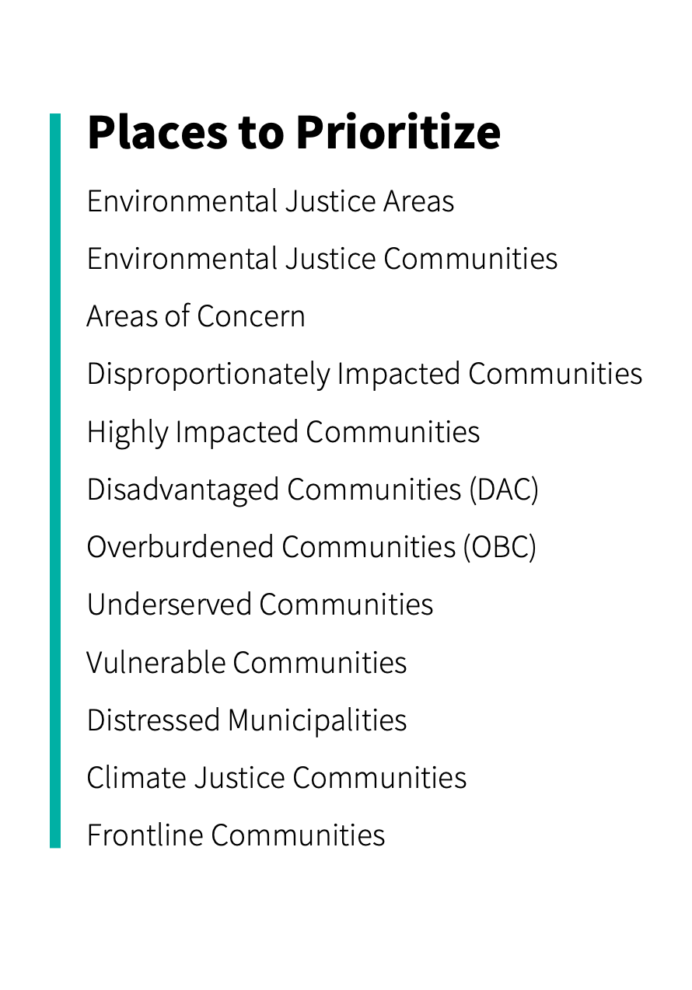
From Screening to Identification: You may have seen the term “screening tool,” “index score” as well as “criteria,” “definition,” or “list” of communities. Here’s a quick guide to how governmental or decision-makers might use each.

Any of these tools can be used to identify priority populations, though they vary in flexibility and consistency. A screening tool could be used to identify specific communities (e.g., top 25%), or assess different vulnerabilities or impacts for different purposes. However, it may be difficult for a community to know if they are eligible or qualify for additional consideration, funding, etc. A communities definition or list provides a single way to understand community eligibility. However, depending on the data/indicators that are used, the basis for identifying communities may not directly relate to the decision or issue. Thankfully, these options are not mutually exclusive. Some states developed (or are developing) screening tools before, or as part of, identifying specific communities. For example, CalEnviroScreen is a screening tool with an index score, and the scores are used to identify communities for tracking California Climate Investments (CCI).
Priority Populations for California Climate Investments
Disadvantaged communities are currently defined by CalEPA as the top 25% of communities experiencing disproportionate amounts of pollution, environmental degradation, and socioeconomic and public health conditions according to the Office of Environmental Health Hazard Assessment’s CalEnviroScreen tool.
Low-income communities and households are those with incomes either at or below 80% of the statewide median or below a threshold designated as low income by the Department of Housing and Community Development.
Simple vs. complex definitions: Across the states we reviewed, we found that numerous states started simple, often using a few sociodemographic indicators. With so much attention on multivariate index scores, I was surprised to find simpler approaches, that had still gone through after thorough careful consideration and analysis (e.g., Massachusetts SB 9). Some states are using an interim definition while they assess more data (e.g., NY, and CO). Colorado’s interim definition includes only three indicators (income, minority, housing-cost-burdened) while they build a screening tool to assess to identify communities “where multiple factors, may act cumulatively to affect health and the environment and contribute to persistent health disparities,” (Colorado HB21-1266).
Trends in State Approaches to Geographic Definitions
How are they identifying communities?
Most states (with EJ community legislation) are developing lists of specific communities, though screening tools may be available for other considerations/decisions
Many states use just a few indicators (2-3 sociodemographics) though some (NY, CO) have interim definitions that will be expanded.
California has used a combined index for nearly 10 years,
and several states follow the CalEnviroScreen approach (WA, MI).
Some states are developing screening/mapping tools before a combined index (CO, HI).
What data/information is included?
Many states use only sociodemographic factors
to identify communities.
Though some recent definitions include environmental factors (IL, WA, NY, MI), other new definitions (MA, NJ) do not.
Some states plan to include climate risks/hazards/burdens in their community definitions (HI, VT, NY), though their approaches are in development.
Nearly all definitions focus on the characteristics/experiences of households. Few definitions include business or industry characteristics or conditions.
Takeaway: Many states start simple
Data and indicators to include: What indicators should be included? There is no right answer; it comes down to how the definition will be applied. You can group indicators into “People” characteristics (sociodemographics, health, housing conditions and costs, etc.), and “Place” characteristics, which traditionally include environmental exposures and burdens (e.g., air pollution or water pollution; proximity to polluting facilities), and more recently climate change risks (extreme weather, flooding, heat vulnerability, distance/access to emergency services, etc.). In addition to the applications and flexibility you need, the more indicators you include, the less influence each has. Because of the deep legacy of environmental racism and discrimination, some indicators are highly correlated, so it may not be necessary to include every indicator to capture cumulative impacts. The EJ Primer has a longer list of potential indicators, as does the NY Disadvantaged Communities draft criteria and WHEJAC interim guidance.
Are different indicators needed for different decisions or processes?
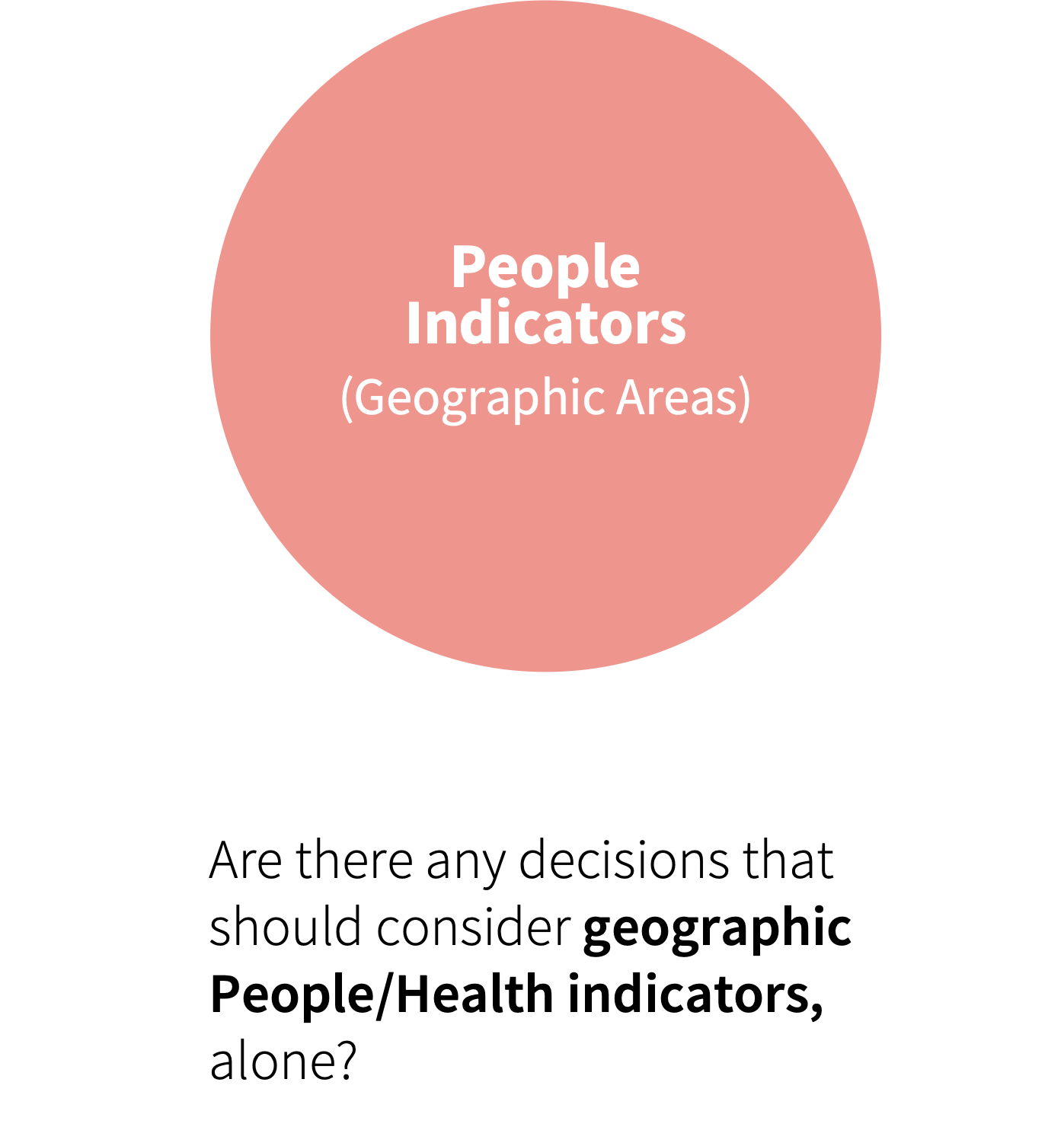
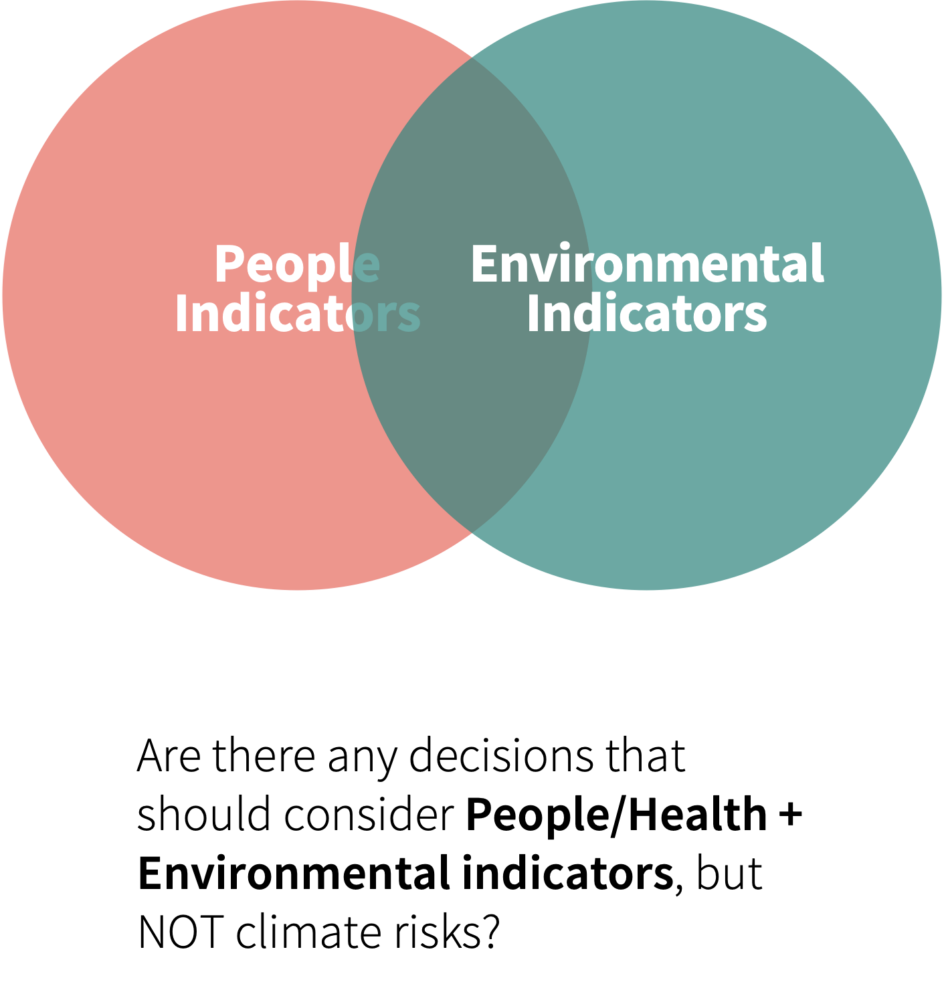
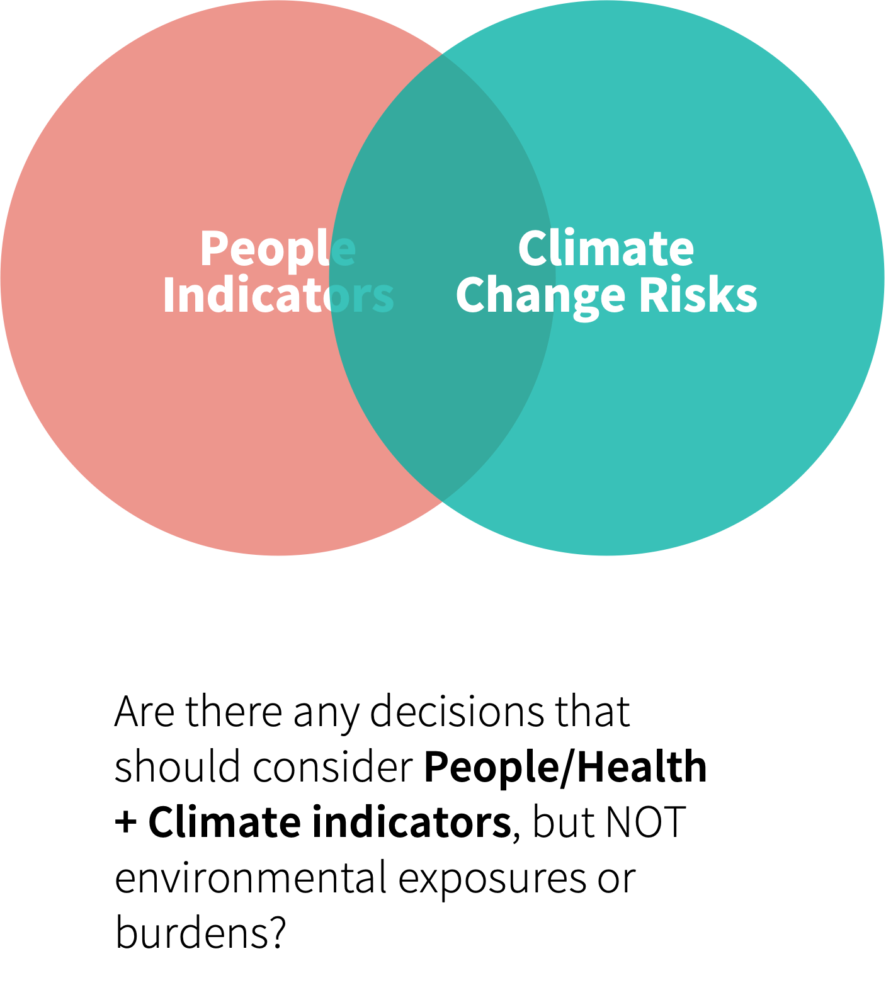
Cumulative Impacts and Adaptive Capacity: A foundational concept of Environmental Justice is “disproportionate impacts,” and by extension “cumulative impacts.” According to Charles Lee of the USA EPA in his article A Game Changer in the Making? Lessons From States Advancing Environmental Justice Through Mapping and Cumulative Impact Strategies disproportionate impacts are “a consistent pattern of greater exposure to multiple and cumulative environmental and social stressors falling on the same populations and places—primarily people of color, low-income, or indigenous.” It follows that cumulative impacts are the combination of disproportionate impacts, which are assessed through methods like an EJ screening tool. As consideration of EJ/CJ communities is applied to climate and energy, some states and EJ/CJ leaders are talking about “adaptive capacity,” or the social, economic, and cultural resources and ability of individuals and groups to respond to threats and change. Some states are grappling with the question of whether the people and places at greatest risk for climate change impacts are best identified by cumulative impacts, or whether a slightly different orientation to vulnerability and adaptive capacity may be appropriate to plan for climate change.
Environmental Burdens in Community definitions: A second decision in what data to include is whether to go beyond sociodemographics. EJ and CJ definitions are often intended to capture people and places who have either experienced or are at risk for negative effects of environmental burdens or climate change. While at first blush it may seem critical to include environmental burdens, especially if the score or definition will be used for siting or permitting, this isn’t standard practice, States take two approaches – either including or “baking in” historical environmental burdens to reflect cumulative impacts, or identifying communities based on sociodemographics who may be vulnerable or at risk due regardless of past exposures.
This was the big ah-ha moment for our review: The indicators you use in an EJ/CJ or disadvantaged communities don’t need to be the same indicators you consider in decision-making. For example, you could develop a simple definition based on sociodemographics alone, to be used together with a screening tool or environmental impact assessment that considers the location and cumulative burden of existing facilities. California’s Environmental and Social Justice Action Plan, Massachusetts SB-9, and New Jersey’s Environmental Justice Law are examples of an EJ/CJ community definitions going together with equity processes. We heard (and inferred) a variety of reasons for focusing on sociodemographics (image below).
Why wouldn’t you include environmental factors in an EJ community definition?
Great question! We don’t have a definitive answer but here are some theories.

- Environmental factors may still be considered in decision-making – e.g., through impact assessment – so excluding them from definition doesn’t mean environmental exposures or burdens aren’t considered
- Many state agencies define EJ and/or EJ communities through their federal obligations under Title VI and refer to EO 12898, which only refers to minority populations
- People’s vulnerability adaptive capacity is often primarily associated with sociodemographics (income, race/ethnicity, language, renter status; social ties and resources)
- Some communities want to be included or considered on the basis of income, race and/or health regardless of facility/industry locations
Planning for Climate Impacts: Building an EJ/CJ Communities definition for climate change is relatively new, though under consideration at the federal and state level (Justice40 CEJST, NY Draft DAC, Hawaii’s “frontline communities” HCR112). Climate indicators like sea level rise, flooding, extreme heat or precipitation, drought, or infrastructure damage can be both historical and forward-looking. Like environmental burdens, stakeholders need to decide if they want to account for place-based differences in risk or prioritize some people regardless of place-based risk. For example, models identifying areas at high risk could be used with sociodemographic and health data to identify communities with both high relative risk and limited adaptive capacity. However, like including environmental burdens, states could also maintain a simple sociodemographic definition and consider different climate risks when prioritizing different types of funding or assistance.
Going Beyond Geography: Priority populations can also be defined by non-geographic characteristics, such as the EPA’s “populations of concern.” The geographic approach has roots in environmental decision-making (e.g., facility permits and siting) which is place-based, though increasingly an EJ approach is being taken for clean energy and energy efficiency decisions or spending, which may have a non-geographic component (e.g., low-income spending or rate impacts). The recently-released beta version of the Climate and Environmental Justice Screening Tool (CEJST ) starts with census tracts, though Justice40 interim guidance allows for a non-geographic definition as well. California’s early definition of “Disadvantaged Communities” for the purposes of allocating California Climate Investments was geographic but was later expanded the definition to include low-income households anywhere. Similarly, New York’s draft definition of Disadvantaged Communities includes low-income households for the purpose of allocating energy and clean energy investments.
How could individual or household characteristics work with a geographic definition?
What decisions should consider population/health characteristics regardless of where people live?
Are there any decisions that should consider both geography and characteristics?
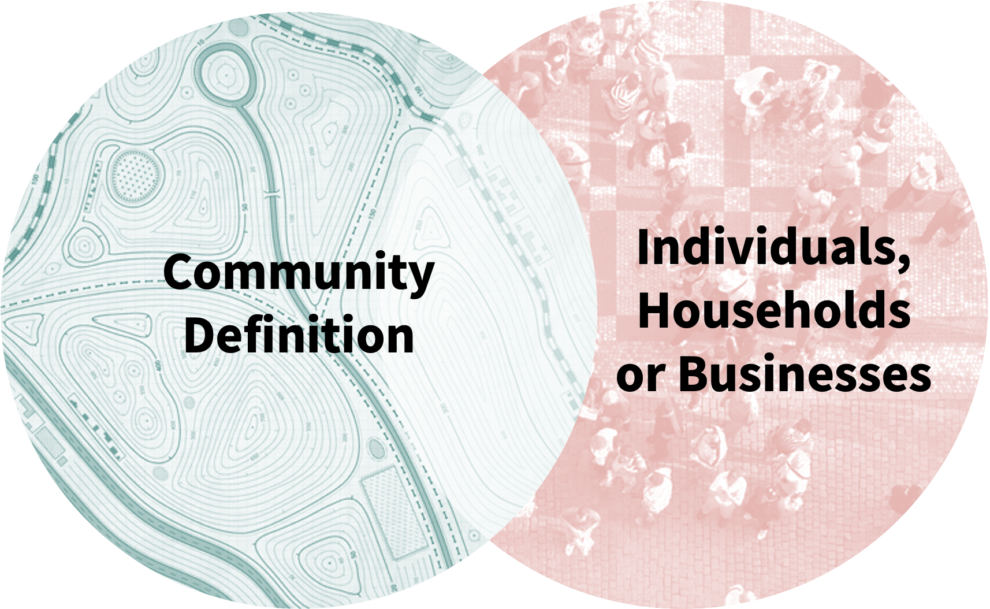
Conclusions and Open Questions: Big picture – there is no right answer, or best practice. States are taking different approaches based on their needs, legislation, and applications. The data can be combined in many ways and there is no perfect analytical solution. Knowing this is crucial because it means that there are nuances to EJ/CJ issues. These tools and criteria are helpful, but ultimately reinforce what people in these communities have experienced, in some cases for decades, and thus should be malleable by design. What stuck out to me was understanding that the “communities” definition or list is not the be-all or end-all of equity, EJ or CJ processes – it can be one part of a robust approach to community input, assessment and consideration and treatment in actions and decisions (“fair treatment and meaningful involvement”).
Additionally, these definitions and criteria are impactful insofar as they are used to draft and enforce meaningful policies. From our experience in NY, I think the test is really with your stakeholders – whether they understand it, and feel it meets their experience and concerns, and whether they can and will use it.
Acknowledgments: ILLUME’s EJ/CJ primer (available on request) is based on our ongoing review of state and federal definitions and screening tools, including meetings and discussions with staff at New York State Agencies, California Office of Environmental Health Hazard Assessment (who developed CalEnviroScreen), the CPUC, Washington State, the U.S. Digital Services (developing the federal Climate and Environmental Justice Screening Tool), FEMA, and academic researchers. ILLUME also maintains an internal database of state policy around equity and EJ definitions and is continually tracking and monitoring legislation and screening tools.
The images above are excerpts from a primer sponsored by the U.S. Climate Alliance and is available upon request.
